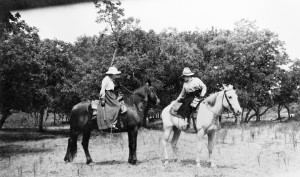
Following the publication of Owen Wister’s The Virginian in 1902, Western novels became extremely popular, and several Montana women became successful genre writers. These writers, including Caroline Lockhart and Bertha Muzzy Sinclair Cowan (best known as B. M. Bower), drew inspiration from the life, land, and folklore of Montana. Their stories suggest the enduring place that Montana has in the imagined, symbolic West. They also reveal the role gender discrimination played in popular expectations about Westerns and their creators.
Scholar Jane Tompkins has explored the power of the Western—both in novels and on film—in the American psyche. She argues, “The West functions as a symbol of freedom, and of the opportunity for conquest. It seems to offer escape from the condition of life in modern industrial society. . . . [T]he creak of saddle leather and the sun beating down, the horses’ energy and force—these things promise a translation of the self into something purer and more authentic, more intense, more real.” This version of the West was decidedly masculine. And while largely mythic, it was an idea that was wildly popular—especially among the country’s young men—from 1900 to 1975. Continue reading Writing a Rough-and-Tumble World: Caroline Lockhart and B. M. Bower